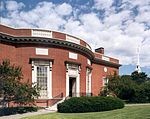Widener Library

The Harry Elkins Widener Memorial Library, housing some 3.5 million books in its "vast and cavernous" stacks, is the centerpiece of the Harvard College Libraries (the libraries of Harvard's Faculty of Arts and Sciences) and, more broadly, of the entire Harvard Library system. It honors 1907 Harvard College graduate and book collector Harry Elkins Widener, and was built by his mother Eleanor Elkins Widener after his death in the sinking of the RMS Titanic in 1912. The library's holdings, which include works in more than one hundred languages, comprise "one of the world's most comprehensive research collections in the humanities and social sciences." Its 57 miles (92 km) of shelves, along five miles (8 km) of aisles on ten levels, comprise a "labyrinth" which one student "could not enter without feeling that she ought to carry a compass, a sandwich, and a whistle." At the building's heart are the Widener Memorial Rooms, displaying papers and mementos recalling the life and death of Harry Widener, as well as the Harry Elkins Widener Collection, "the precious group of rare and wonderfully interesting books brought together by Mr. Widener", to which was later added one of the few perfect Gutenberg Bibles—the object of a 1969 burglary attempt conjectured by Harvard's police chief to have been inspired by the 1964 heist film Topkapi. Campus legends holding that Harry Widener's fate led to the institution of an undergraduate swimming-proficiency requirement, and that an additional donation from his mother subsidizes ice cream at Harvard meals, are without foundation.
Excerpt from the Wikipedia article Widener Library (License: CC BY-SA 3.0, Authors, Images).Widener Library
Massachusetts Avenue, Cambridge
Geographical coordinates (GPS) Address External links Nearby Places Show on map
Geographical coordinates (GPS)
| Latitude | Longitude |
|---|---|
| N 42.373444444444 ° | E -71.1165 ° |
Address
Harry Elkins Widener Memorial Library
Massachusetts Avenue
02163 Cambridge
Massachusetts, United States
Open on Google Maps






